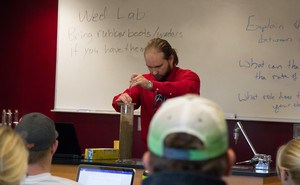Rangeland labs generate hands-on learning

CHADRON – Applied Sciences Assistant Professor Tony Perlinski encourages his students to play in the dirt. Luckily for the students enrolled in Perlinski’s soils laboratories at the Rangeland Complex on the southeastern edge of campus, they’re surrounded by plenty of it.
“Other range programs don’t have the on-campus resources we have,” Perlinski said. “We walk out our back door and we’re in rangeland. Because of that, we can teach differently.”
The Rangeland Complex, which was dedicated Sept. 26, 2015, features a laboratory and classroom building, as well as the 25,000 square foot Coffee Agriculture Pavilion. The Coffee Pavilion provides space for livestock classes and rodeo practice, while the Rangeland Lab has two dedicated spaces for animal dissection and soil analysis.
Perlinski, who teaches all his courses in the soils lab, said the modern lab amenities are useful, but the living laboratory outside is also involved in the curriculum.
“Rangeland is a hands-on program and so it makes sense for us to study outside,” he said. “Getting students into the rangelands and teaching students what they’re going to be doing is valuable. We are providing skills and experiences they can put on their resumes and that is important. Being able to talk about a concept in the classroom and demonstrating it in the field is extremely high impact.”
Assisting those high impact practices is campus Horticulturist Lucinda Mays and grounds employees. Perlinski said Mays is attentive to the needs and requests of Rangeland faculty about what to plant in the living laboratory.
“Lucinda and the grounds crew do a lot of great stuff for our program. They’ve planted a lot of native grasses and plants and because of that we draw really heavily on using the outdoor lab space. They’re open to whatever we are trying,” he said.
Perlinski is willing to try almost anything. Earlier in the fall semester he and his class did a small prescribed fire to see the effects it had on control and invasive cool season grasses.
“We won’t know for sure the effects it had for some time, but some of the burn areas promoted some new, intense regrowth,” he said. “It’s part of a larger project where we are reseeding native species in those burned areas.”
While the living laboratory has provided several opportunities for high impact learning, the indoor facility is no slouch.
“We are still growing into it and what we can do with the lab indoors,” Perlinski said. “We’ve been here a year and a half, and so to be honest I’m still figuring out what to do with this space. But this facility is so important to our program.”
The lab features six workstations for four students apiece, along with scientific instruments and other equipment.
“The soils lab is the primary use of those stations but we also use those spaces to process samples for habitat inventory and analysis and rangeland hydrology,” Perlinski.
Each lab was built to accommodate 24 students, but Perlinski said some courses have as many as 30 students.
“That’s a great problem to have because it means our program is successful,” he said.
Perlinski has also had a successful year. In the summer he successfully defended his dissertation and earned a Ph.D. from the University of Wyoming in Watershed Management. He was also recently elected the President of the Nebraska Section for the Society of Range Management and serves on the Advisory Council as Chair for the International Society of Range Management.
“I enjoy giving back and working with rangeland,” he said. “And, I have a hard time saying no.”
Category: Campus News, Range Management

